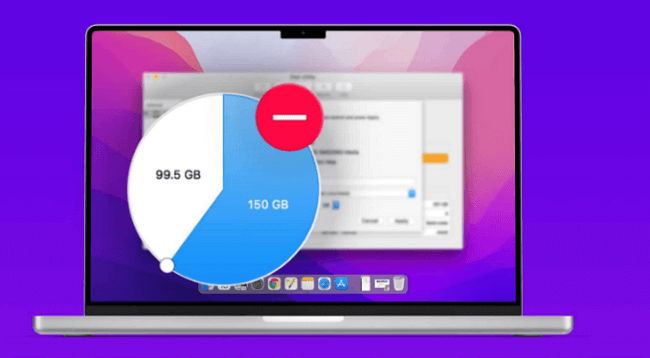Do you use a Mac? Have you noticed that you are running out of your Mac storage? Recently, many Mac users have complained about “why the system has been occupied with so much data storage?” “How to clear system data storage?” If you are searching for this, please keep reading below. This paper will show you how to clear your system data storage.
What is System Data on Mac
System data includes system software installed by Apple. This resource is important for the normal functioning of the system and is located in the boot volume. That is to say, we can take Mac’s system data as the system composition, including the macOS operating system, temporary files, app extensions and plugins, cache files, disk images, and archives, including .dmg, .zip, etc., and old backups.
Though the system data is important, some of them are not necessary. As time goes on, the size of the system data will be bigger and bigger, and it will drag your Mac’s speed slowly and make your storage capacity weaker.
That is why you need to periodically clear the system data storage to enhance the Mac’s performance.
How to Check Mac Storage?
Before clearing the data storage on macOS, it’s necessary to check the condition of the Mac storage space. Then, you can choose the best method to free up the storage space besed on the actual situation of your device.
🌟 If your Mac is with macOS Monterey and earlier:
Step 1. Go to the Apple menu > click About This Mac.
Step 2. Select the Storage tab on the pop-up window.
Step 3. Hold your mouse over the System Data, and it will show you how big the section is.
🌟 If you are using a Mac with macOS Ventura:
Step 1. Open the Apple Menu > choose About This Mac.
Step 2. Click the More Info button (to navigate to the General tab in System Settings.)
Step 3. Find Storage > click Storage Settings.
Step 4. It will show the Storage bar > put the cursor on it to find System Data > you can check the storage it takes up.
You May Need: What is the User Folder on Mac 🔥
How to Clear System Storage on Mac Step by Step
After understanding the types of system data that take up your Mac storage space, you can clear the unnecessary files according to the characteristics of each data type. The following five methods will offer you the solution to the question “How to reduce system data on Mac”.
Method 1. Empty Trash on Mac
Empty the Trash could permanently delete parts of the redundancy, and unnecessary system data in the Mac. We often forget the files in the Trash, and these files quickly become larger in size.
How to reduce system data on Mac by emptying the Trash manually:
Step 1. Right-click the Trash icon on the Dock.
Step 2. Click Empty Trash on the pop-up Window.
Besides emptying the Trash manually, Apple also provides you with a default function to optimize the storage.
let’s check out how to get rid of system data on Mac using this function:
Step 1. Apple > About This Mac.
Step 2. Choose the Storage option, and then click on the Manage button.
Step 3. Now, the “Recommendations” tab will show at the top of the left sidebar.
You can see some useful suggestions as shown in the picture. By this, you can also turn on Empty Trash Automatically, it will delete useless files in the Trash for more than 30 days.
Related Post: How to Show, Hide, Find and Empty the Recycle Bin ✨
Method 2. Delete Time Machine Backups
Mac Time Machine‘s local backups and snapshots consume a lot of your computer’s system storage space. The Time Machine creating snapshots every day is one of the main reasons for taking up system space.
If you are running out of space, deleting the old, unused backups and snapshots to free up storage space is a great choice. Follow the steps below.
Note: This method can help you free up more system storage space on your Mac device. But for those who are afraid of losing some essential files, it would be safer to wait for the automatic deletion of macOS.
🌟 Delete Time Machine Backups:
Step 1. Launch Terminal.
Step 2. Type tmutil listbackups > press Enter.
Step 3. A list of stored backup files will show by date. Choose what you want to delete.
Step 4. Back to Terminal, type sudo tmutil delete followed by the path to the backup, it would include: [user name]/[disk name]/[YYYY-MM-DD]. Press Return.
🌟 Delete Time Machine Snapshots:
Step 1. Launch Terminal.
Step 2. Type tmutil listlocalsnapshots / with the space before / > press Enter.
Step 3. Wait and you will see the list of snapshots.
Step 4. Type tmutil deletelocalsnapshots xxxx (xxxx is the name of one of the files listed.) It is in the form of a date followed by a text string. > press Enter.
If you want to delete another snapshot, just repeat the steps as many as times you want to remove it. After that, you can check the Storage tab in About this Mac every time to see how much space you’ve freed up.
Method 3. Delete iOS Backup Files
We have talked about how to delete the Time Machines Backup above. Besides the Time Machines Backup files, the iOS Backups will also take up a lot of storage space, if you have backed up your iPhone on your Mac.
How to free up space on system data on Mac by removing iOS backups:
Step 1. Choose Apple, and click on the About This Mac button. Then, move to the Storage tab and choose Manage.
Step 2. The Storage Management window will appear on your screen.
Step 3. Now, you need to choose the “iOS Files” option on the left sidebar. You just need to select the Delete Backup and confirm your operation.
Method 4. Clean Up App Logs and Junk Files
When you are using applications and programs, they will generate files in your system. These files help improve your experience within the apps. But, once you uninstall these apps and programs, these leftover files may still be left on your Mac.
How to clear up space on Mac by deleting App logs:
Step 1. Go to the Finder.
Step 2. Click the Go menu and then click Go to Folder.
Step 3. Type ~/Library/Application Support > press Enter.
Each application’s folder has a corresponding name. You can delete folders belonging to uninstalled applications.
You can also search for related application data in these locations:
~/Library/Caches
~/Library/Logs
~/Library/Containers
~/Library/Cookies
Please note that you’d better not delete the files belonging to the apps you are still using.
Method 5. Clean Up Downloads Folder
Like Microsoft computers, Mac also has a default downloads folder. It is used to store the data of various things we download, such as photos, videos, PDFs, installation programs, and so on. These data will increase your system data storage space.
Here’s how to delete system data on Mac:
Step 1. Go to Finder > Downloads.
Step 2. Delete the files that you won’t need anymore.
Bonus Tip: How to Recover Mac System Data Deleted by Mistake
Here’s the thing, if you clean up your system files but accidentally delete your important files. We can use third-party Mac data recovery software to retrieve them.
As an all-in-one data recovery software, ONERECOVERY supports restoring various types of files, including video, audio, document, and photo. ONERECOVERY offers you two types of scan modes, i.e., Quick Scan and Deep Scan, so that you can choose the most suitable one for your data recovery.
Whether you want to recover files deleted from recycle bin, from an external drive, or SD card, this recovery software can always be helpful. And the intuitive interface enable everyone to use it effortlessly.
Here is how to recover the file on Mac step by step:
Step 1. Launch it> select your deleted file location to scan.
Step 2. Preview the results and pick the files you want to recover.
Step 3. Save the file to a new location.
Related Post: How to Recover Files from a Dead Laptop
Wrap Up
After introducing 5 solutions on the issue of how to clear system data on Mac, we believe you have a deep understanding of it. And, in case there’s any mistake deletion of the system files, which would affect the Mac, we have introduced you to ONERECOVERY to support you.
FAQs About macOS System Data
The following FAQs will benefit you if you want to know more about the system data on Mac.
There are a couple of reasons:
- System Updates
System update is a major factor in the system’s high disk space usage on your Mac. The update files for macOS consume many gigabytes of space on your hard disk every time Apple releases a new version of the operating system.
- Applications and Files
On your Mac, the programs and files you download and use also occupy system space. The more programs and software you download, the more space they take up. For instance, some apps generate a lot of space-consuming temporary files or cache data, and large media items like pictures, videos, and music can also consume a lot of storage space.
- System Files and Caches
A large number of different system files and caches are required for the normal functioning of a computer and to extract data. These files include, such as operation logs, program caches, temporary files, drives, and so on. So, as you use your computer longer, the more system data the system generates, the less storage space you have.
- Virtual Memory
With the help of the virtual memory feature in macOS, you may make use of your computer’s hard disk as if it were RAM. While this could improve performance, a lot of hard disk space might also be consumed.
If you are wondering about “can i reduce system data on Mac,” this FAQ will give you the answer. While it is technically possible to delete system files on a Mac, it is risky.
Apple doesn’t allow you to access system data and macOS. If you put the cursor on system data in macOS Ventura, you see nothing but a gray bar, the same in macOS Monterey and earlier versions. It is because the system files are critical to the functioning of your Mac computer. Deleting any of these files would have a chance to cause your Mac to malfunction, resulting in crashes, errors, and other problems. That’s why Apple doesn’t simplify the process of deleting anything from your system data or macOS system. But you can.
There’s no “Clear” or “Delete” button to wipe these files in macOS, so you’ll have to manage your storage space yourself. We’ll guide the steps of how to do this next. But, we would also like to say that before carrying out the operation, we recommend backing up your Mac in order to restore it to its previous state in case of any problem. Also, in case of file loss issues, we can use third-party recovery software to retrieve those files.
Vanessa is a professional editor with a strong foundation in computer information technology. Since graduating, she has dedicated her career to create content in IT fields. In the past three year, she has accumulated sufficient knowledge in data recovery, computer problems troubleshooting and application of multimedia software.
She has been trying her best to bridge the gap between complex technical concepts and accessible, reader-friendly content.







